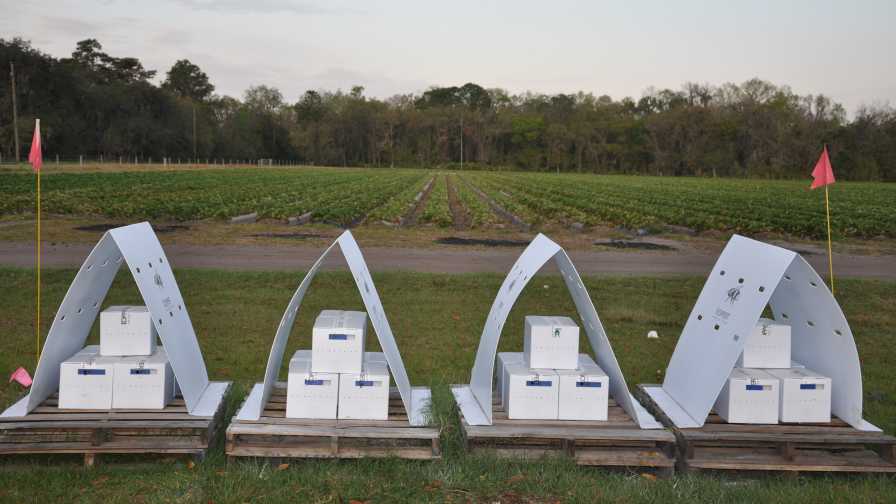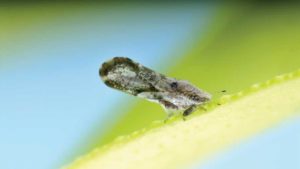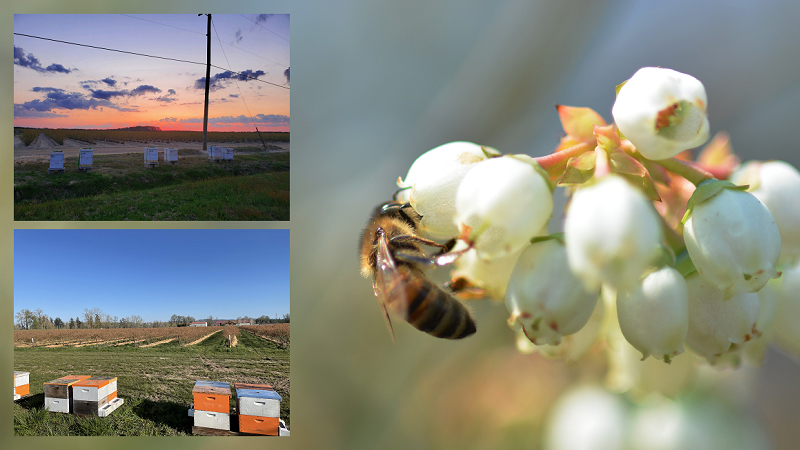Insects (Bad and Good) Make for Interesting Field Trips
Recently, I had a chance to get out of the office and see what’s happening on the research front. Both onsite visits focused on insects — one good and one bad.

Bees travel through a biological material that is delivered to strawberry blooms to fight disease.
Photo by Frank Giles
Buzzing Disease Fighters
I was invited to visit a demonstration of a new technology being develop by a company called Bee Vectoring Technologies (BVT). The demonstration was held on a grower/cooperator’s strawberry field near Plant City.
Among my hosts was BVT CEO Ashish Malik. As we were driving to the demo, he asked me: “How comfortable are you around bees?” I replied, not convincingly: “Well, fairly comfortable. I guess.”
Ashish informed me the bumble bee hives we were about to see had been moved a little earlier and they were a bit “agitated.” The good news was the bees were fine and calm when we arrived. I was impressed by what those bees were doing as they forage the strawberry field near the hives.
These are not normal hives. As bees leave the hive, they pass through a tray of a biological material, which fights common fungal strawberry diseases like Botrytis gray mold. As the bumble bee does its normal pollination duties, it delivers this biological control to strawberry plants. This takes unmanned aerial systems to a whole new level. The company’s proprietary biological material is called BVT-CR7. When the bees deliver it to strawberry flowers, it helps prevent the development of Botrytis.
Ashish told me grower trials look promising and hopefully will allow growers to reduce their reliance on traditional fungicide applications, increase yields, and extend shelflife. He says the product is currently under EPA review for labeling.
“We did a lot of work last year to prove the safety of the product and presented the dossier to EPA in September,” Ashish said. “We expect registration in the first half of 2018, then we will begin sales. In the meantime, we are working with growers to demo the product.”
Keep Controlling Psyllids

An extreme close-up of HLB’s vector, the citrus psyllid.
Photo by Jeffrey W. Lotz
In March, the International Research Conference on HLB was held in Orlando. In late April, a grower day was hosted at the Citrus Research and Education Center (CREC) in Lake Alfred to present results of the Conference in a way that’s more digestible for non-academics like myself.
What we learned during the grower day is that there is a lot of research all over the globe going on to try and find solutions to HLB. Unfortunately, there were no major breakthroughs to report on — yet.
So, the take-home message of the day was that spraying the psyllid, spoon-feeding fertilizer, and minding citrus root health are still about the only games in town when it comes to fighting HLB. There was a particular emphasis on psyllid control in the meeting and the question: Should I continue to spray for the psyllid if 100% of my grove is infected with HLB?
The resounding response from scientists is YES. Michael Rogers, CREC Director, said there is research that shows the more often psyllids reinoculate a tree, the quicker it declines.
Rogers also presented data that showed “intermittent managed” (two to three insecticide applications per year) groves are the highest source of psyllid populations — even worse than abandoned groves. So, if you are near groves with very little or no psyllid control, it is a problem.
The grower day also highlighted promising research around genetics and the use of CRISPR technology to fight HLB; but again, those are some years out. So if you grow citrus, keep the faith and keep killing those psyllids.










